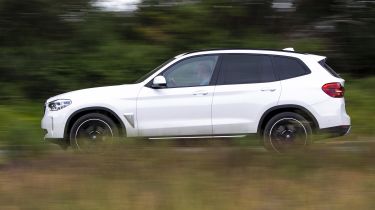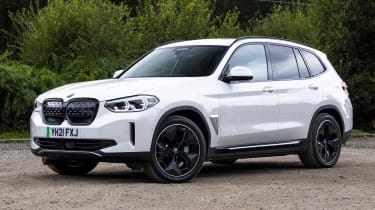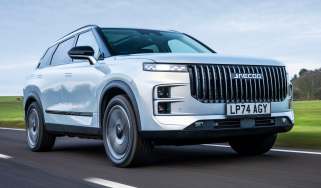BMW iX3 SUV - Range, charging & running costs
The iX3 features a novel recuperation setting that slows the car at the same rate as traffic
Pros
- Range
- Refinement
- Practicality
Cons
- Firm ride
- Faster rivals
- Unadventurous design
By adding an EV option to its popular X3 range, BMW boasts that customers can now choose between four different powertrains for its mid-size SUV. It adds to the existing petrol, diesel and plug-in hybrid range, giving low to medium-mileage drivers the chance to shun traditional fossil fuels altogether.
BMW iX3 range & charging
The iX3 has an 80kWh battery beneath its floor, allowing it to cover up to 285 miles on a charge. That's competitive with the 292-mile range of the Jaguar I-Pace, and betters the 249 and 274-mile range of the Audi e-tron and Mercedes EQC respectively.
Like the e-tron, the iX3 also supports rapid 150kW charging at compatible public locations, topping the battery up to 80% in just 27 minutes. The Mercedes and Jaguar can be topped up at around 100kW, so take longer to recharge. A home charge using a 7kW wallbox should take under 12 hours and it's also possible to charge using a three-phase 11kW charger. On our test drive, it also appeared to be very efficient, returning up to 2.7mi/kWh despite wintry weather conditions giving a range of around 250 miles. In our hands the EQC and e-tron return more like 2.0 to 2.2mi/kWh in normal driving.
More reviews
In-depth reviews
As with any electric vehicle, the iX3 has the potential to significantly reduce running costs for the owner, and we particularly enjoyed one new feature for its energy recuperation system. Like most new EVs, the braking effect of the electric motor can be increased, and with practice it's possible to drive the iX3 in traffic with almost no use of the brakes. However, BMW has also added an ‘Adaptive’ setting, which automatically adjusts the recuperation to match the car ahead, a bit like adaptive cruise control for braking alone. It works well, carefully adjusting the regenerative effect to match cars in front, even when they modulate their deceleration.
Thanks to its zero emissions, the iX3 qualifies for free VED (car tax) and a low BiK rate of 1% to 2%company-car drivers in the next two years.
Insurance groups
The insurance band for the iX3 is high, sitting in group 44 out of 50. However, its rivals are all costly to insure, with the I-Pace in group 49 out of 50 and the Audi e-tron in the very top group. The fact the iX3 is the least powerful model of the group seems to make the difference here.
Warranty
BMW sells all its cars with a three-year/unlimited mileage warranty, which is on a par with Mercedes and slightly more generous than Audi (with a 60,000-mile cap). Tesla models come with a four-year or 50,000-mile warranty. It's likely the BMW iX3 will have a longer warranty covering its battery (many rivals offer eight years of cover), but details of this have yet to be announced.
Servicing
BMW models are fitted with an array of sensors to determine when servicing is required, so there isn't a strict routine to stick to. Typically, services won't be more than two years or 20,000 miles apart, and it isn't the cheapest. BMW does offer servicing packages though, making it possible to spread the cost over monthly payments.












